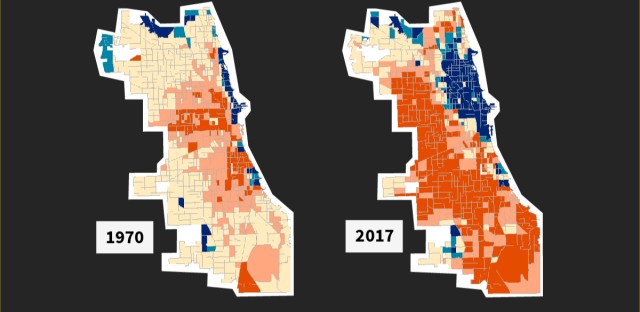via wbez.org:

Chicago’s middle class, once the backbone of the city, is declining so swiftly that it’s almost gone, and a set of maps from a local university lays that reality bare.
The dynamic stands to affect nearly everything about Chicago going forward, from politics to schools to who will live here.
“It raises a lot of questions as to what kind of city it will be,” said Janet Smith, co-director of the Nathalie P. Voorhees Center for Neighborhood and Community Improvement at the University of Illinois at Chicago, which compiled the maps that document Chicago’s shrinking middle class — and an increasingly polarized city — over the past five decades.
Don’t see the graphic above? Click here.
UIC’s maps show that fully half of the city was middle income in 1970, including large swaths on every side of town. Today, just 16 percent of the city’s 797 census tracts are considered middle income. Those middle income areas are confined mostly to the corners of the city, and to thin strips between areas of wealth and poverty.
“We have two cities,” said Smith, who notes other cities are headed in a similar direction. “We have the rich and we have the poor.”
For UIC to consider a census tract middle income, the average per capita income there had to fall between $28,712 and $43,068. (UIC researchers said per capita income is useful for mapping wealth and poverty, but doesn’t necessarily represent what a person would earn.) Median household income in the Chicago metro area is $68,403.
What’s middle class?
There are lots of ways to define the “middle class.” Here’s how Voorhees Center/UIC researchers defined middle-income earners: Using U.S.Census data, they calculated the average per capita income across the entire Chicago metropolitan region for each year of the U.S. Census, beginning in 1970. A city census tract was considered “middle income” if its average per capita income fell between 80 and 120 percent of the metro-wide average for that year.
Chicago has long been defined by its stubborn racial segregation, but income segregation is “more extreme now” than in the past, Smith said.
Many of the neighborhoods that were middle income in 1970 are now lower income.
“But what’s been more striking is a significant increase in high-income people moving into the city,” Smith said.
Just 8 percent of Chicago’s census tracts were considered high or very high income in 1970. Today, more than one-fifth of the city’s census tracts are higher income.
Don’t see the graphic above? Click here.
Racial change drives early disappearance of middle class
When Harry Meyer was growing up in Gage Park, the neighborhood was solidly middle class. Looking back, “we never had any concern. Never missed a meal, never had any worries about that. My mom didn’t work until I was in high school. She stayed home and took care of the house and things.”
Meyer’s dad, a foreman at a local factory, was the family’s sole breadwinner. They lived in the upstairs apartment of a brick two-flat on Rockwell Street that Harry’s grandfather had built. His uncles lived in the apartment below.
Meyer stayed in that home until the 1990s, when he said the whole neighborhood flipped. “It went from 95 percent white to 95 percent Mexican in that 10-year period.”
Demographer Rob Paral said the map of Chicago’s shrinking middle class is partly showing that sort of racial change, which brought with it an accompanying reduction in average incomes.
“When you go back to 1970, the areas that are considered middle income — those were basically white,” Paral said.
Many of those whites headed for the suburbs during the period of white flight, said Paral. In addition, middle-class African-Americans were also on the move, taking advantage of open housing laws to exit slums where they had been trapped. The map’s expanding lower-income areas align with the growth and geographic expansion of Latino and African-American populations, Paral said.
Today, the Arzate family lives in Meyer’s old home. And it’s a similar set-up. Beatriz Arzate, 30, lives upstairs with her husband and their two kids. Her parents, Mexican immigrants, bought the house six months ago and live downstairs with Arzate’s brother.
Beatriz Arzate stays home with the kids. Her husband works at a pallet company, and has a second job at a Spanish-language radio station. Her dad is a local truck driver.
They invited Meyer inside one recent day to see the house he grew up in. He found a modern kitchen and the same front door he ran through as a kid.